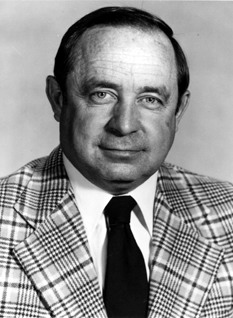To get invited back to write for the Buckeye Battle Cry 2009, we had to let Sean Neugebauer, our editor, write a guest post every now and then. We also had to give him eight chickens and a Slip 'N' Slide, but that's not important. Anyway, here's his take on some of the unexpected joys of conference schedule tinkering.
One of the more interesting things to come out of last week’s mostly uneventful Big Ten gathring, is the fact that the push for a nine-game Big Ten schedule seems to be picking up some steam. As many others point out, this change cannot be made in a way that is mathematically satisfactory. One team a year would be relegated to playing only eight conference games. Kind of stupid, but no big deal, right? I mean, what are the chances that this imbalance would ever affect a conference race? Well, this kind of thing has happened before. Twice. And guess who ended up getting screwed? Your beloved Buckeyes.
 Not a fan of scheduling quirks
Not a fan of scheduling quirksMany of you may know that in 1983 and 1984, the then accurately-named Big Ten played a true round robin schedule. In 1983, the Jack Trudeau-led Fighting Illini went 9-0 and made history as the only team to beat every other team in the conference (and probably the only one ever unless Michigan drops its football program). The following year the Buckeyes won seven of nine conference games and won the conference title outright. After that it was back to the eight game conference slate that we still have today.
While those two years are the only years that all Big Ten teams played nine games each, eight conference teams played the full slate in 1981 and 1982. In what media reports of the time called a quirk* in the conference schedule, Ohio State and Iowa didn’t play each other those years leaving them with one fewer conference game played than their peers. While the most pessimistic Buckeye fans of the time might have foreseen this as a problem, Iowa fans probably didn’t even notice. After 19 consecutive losing seasons, they were probably happy that the short schedule meant that they were guaranteed to finish at least a half game ahead of Northwestern (in the midst of their record 34-game losing streak).
But under third year coach Hayden Fry, the Hawkeyes started to win just as no one else in the conference wanted to take control. Before the last weekend of the season, people were starting to realize that if Ohio State and Iowa won, they would share the title – and that the whole thing could have been avoided. Both prevailed and Iowa got to go to Pasadena while the co-champion Buckeyes got to spend the holidays in Memphis and a date with Navy in the Liberty Bowl.
1982 was even more frustrating for Buckeye fans. Breaking in new QB Mike Tomczak, the Bucks struggled out of the gate resulting in an unprecedented three game home losing streak. After a fartbomb of a 6-0 loss to Wisconsin, Bruce’s team, behind a powerful running game and veteran offensive line, reeled off five straight wins leading up to the Michigan game. Unfortunately this would not be the kind of good old fashioned Ohio State-Michigan battle that would be for all the marbles. Michigan, thanks to their additional conference game, had already wrapped up the outright championship and Rose Bowl trip. Though the Buckeyes bested Michigan and both had only one loss, Ohio State would have to settle for second place, a half game back.
As those years proved, sometimes it is the games that aren’t played that can have the biggest ramifications for the Buckeyes. After 1984, the conference moved back to an eight game schedule and though all teams are in the same boat when it comes to number of games played, it seems that Ohio State has gotten the short end of the scheduling stick more than the rest. Loaded Ohio State teams skipped the formerly meek Northwestern squad in 1995 and 1996 and had to settle for second place one year and a shared title the next.
Though nothing could have lessened the disappointment of blowing it against Michigan State in 1998, a Rose Bowl trip might have helped a bit. Unfortunately, the Buckeyes had to watch as not-on-the-schedule co-champ Wisconsin went to California. Though fans probably didn’t lose much sleep over it in the run up to Tempe, looking back it’s kind of crappy that Iowa also gets to be called 2002 Big Ten champions. Cynics might say that the Buckeyes dodged a bullet in these years by not having to play these teams, but if you’re reading this blog, I’m sure you feel otherwise.
While adding a ninth conference game might lessen the chance of these situations happening, history shows that they won’t solve all the conference’s problems. If the conference does indeed add the ninth game, Buckeye fans should brace for the worst every 11 years.
* The “quirk” was not just an oversight or an evil plan by the conference brass, but rather a long-gestating consequence of Ohio State’s inexplicable stubbornness to accept football’s place at the University. When everyone else in the Big 10 started playing 10 games a year, Ohio State stuck with nine. In 1971, when the rest of the conference went to 11 games, OSU started playing 10. Why? Because the faculty council thought football’s place was too outsized at an academic institution- the same thinking that robbed the 1961 Buckeyes of a chance to play in the Rose Bowl. By the time, they finally joined the modern age and let their football team play 11 games in 1974, Iowa had already scheduled non-conference games to fill out its card for ’81 and ’82. Since those games were against Iowa State, they were non-cancellable under threat from the state legislature.

